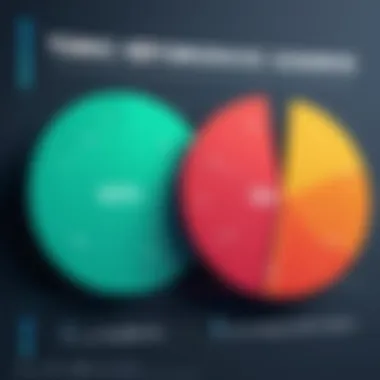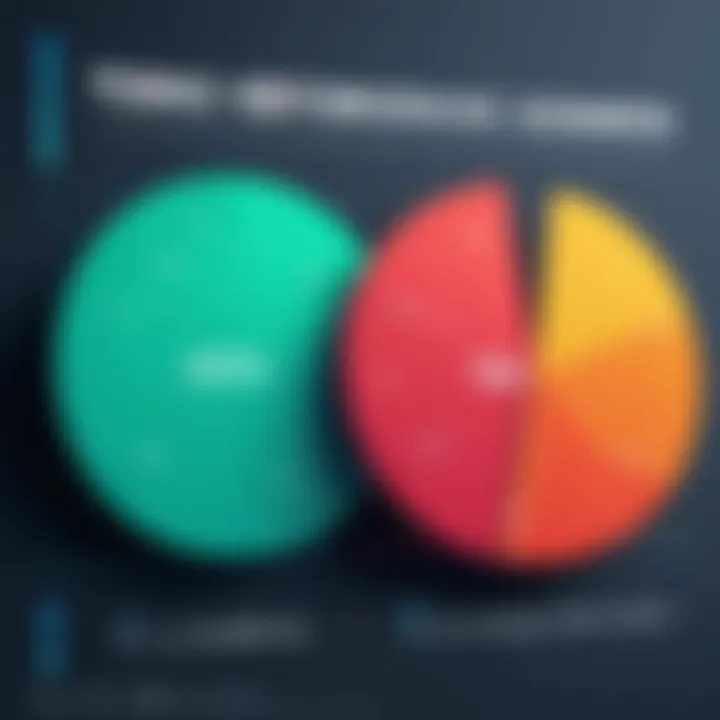A Comprehensive Guide to Tax Return Software


Intro
Navigating the labyrinth of tax return filings can feel like trying to find a needle in a haystack. With the rising complexities of tax laws and the increasing number of options available, deciding on the right tax return software is pivotal for individual taxpayers. Whether you're a freelance photographer juggling gigs or a corporate manager with multiple deductions, the software you choose can either streamline your filing process or leave you scratching your head in confusion.
In this piece, we will dig into the critical elements that influence software selection primarily aimed at individual users. From essential functionalities to pricing structures, we'll explore how these tools shape not just tax return filings but overall financial efficiency. It’s all about choosing what works best for you, helping you avoid unnecessary headaches come tax season.
Key Features and Functionalities
Comprehensive Overview
Not every tax software is cut from the same cloth. Key features can differ significantly between offerings, so it’s prudent to understand what each provides. Some notable functionalities to consider include:
- User Interface: A clean and intuitive design can make a world of difference. A platform that's user-friendly often reduces the time spent figuring it out, letting you focus on actual tax filing.
- Tax Forms Availability: Not all software will support every tax form you might need. Ensure the software covers the forms relevant to your situation to avoid dealing with last-minute surprises.
- Guided Assistance vs. Manual Filing: Some platforms offer step-by-step guidance, which can be beneficial for those unfamiliar with tax regulations. Others might favor a more hands-on approach, allowing advanced users more control.
- Integration Capabilities: Seamless integration with bank accounts or payroll services can help automate data entry, reducing human errors and saving precious time.
Target Users
The target demographic for tax return software seems to be pretty varied. However, some groups may find specific features particularly beneficial:
- Freelancers and Gig Workers: Given the complexities involved in reporting various income streams, they require software that simplifies their unique circumstances, such as self-employment income and potential deductions.
- Families with Multiple Deductions: Parents juggling educational expenses, childcare credits, and home mortgage interest often find robust deduction guidance invaluable.
- Retirees: With different income sources like pensions and Social Security, this group often needs clarity on tax implications, making software with strong customer support essential.
"Choosing the right tax software is not just about ease; it’s about preparedness and confidence in your financial landscape."
Pricing Models and Cost Analysis
Breakdown of Pricing Tiers
Understanding pricing structures can save you a lot of heartache. Most software will have various pricing tiers, typically ranging from:
- Free Versions: These usually cater to simple tax situations. Ideal for straightforward returns but may lack advanced features.
- Basic Packages: Starting around $20-$30, these often offer more forms and guided assistance, perfect for moderate filers.
- Premium Options: For up to $100 or more, users can access comprehensive support, live chat, and advanced tax strategies. For those with complex tax situations, this may be the best investment.
Additional Costs to Consider
When assessing the total cost of tax return software, keep an eye on:
- E-filing Fees: Some software adds a charge for e-filing state returns or additional federal forms.
- Add-Ons: Premium support, tax advice, or extra storage for documents can generate further expenses.
- Upgrades: If you switch from a basic tier to a more advanced plan, the costs can escalate quickly.
Understanding Tax Return Software
In today's fast-paced world, where tax laws constantly shift like sand and deadlines loom large, understanding tax return software becomes crucial for individual taxpayers. Choosing the right software is not just about crunching numbers; it’s about finding a reliable partner that simplifies the filing process, ensuring compliance while maximizing deductions and credits. As tax season approaches, having a clear grasp of what tax return software encompasses represents not only a strategic advantage, but also a means to navigate the complexities embedded in the tax code.
By shedding light on the various elements, benefits, and considerations involved with tax return software, individuals can approach their filing responsibilities with confidence. With numerous options out there, a clear understanding of how these tools work can take a load off one’s mind and streamline the filing process. Plus, being informed about software capabilities can help users avoid unnecessary mistakes and optimize their tax outcomes.
Defining Tax Return Software
Tax return software refers to computer programs designed to assist taxpayers in creating accurate tax returns in compliance with federal and state regulations. These tools typically offer step-by-step guidance through the entire filing process, simplifying complex tax concepts into digestible tasks.
Common features often include:
- Data entry fields for income, deductions, and credits: Allows users to input their financial information easily
- Recommendations based on user profiles: Tailored suggestions for potential deductions or credits based on entered data
- E-filing options: Enables users to file their returns electronically, reducing paper clutter and expediting processing times
- Tax law updates: Keeps users informed about any legal tweaks that might affect their filings
- Audit support: Some software even offer resources or consultations in the event of an audit
Understanding these definitions helps clarify the role of technology in tax filing, highlighting how these solutions can make the process more accessible and less intimidating for average taxpayers.
The Evolution of Tax Return Software
Over the years, tax return software has undergone significant transformation. What once may have started as simple digital forms, where users had to enter data manually, has evolved dramatically into sophisticated platforms that leverage artificial intelligence and machine learning. This advancement has catapulted accuracy and speed far beyond what was conceivable a couple of decades ago.
In the early days, tax software was mostly text-based with little in the way of user-friendly interfaces. Taxpayers often found themselves lost like a needle in a haystack, struggling to decipher complicated instructions. Fast forward to today, and you find a plethora of products that offer intuitive layouts, interactive elements, and even mobile applications, enabling users to file taxes right from their smartphones.
The shift has also involved the integration of cloud technology. Users can now access their tax data from anywhere, which adds a layer of convenience and peace of mind. This evolution shows how technology not only adapts but also enhances user experience, making tax season far less daunting for individuals across the board.
"Gone are the days when filing taxes felt like finding a needle in the haystack; the right software can part that hay before you even begin."
As software continues to adapt to user needs and legal changes, understanding its evolution helps individuals appreciate the capabilities available today, empowering them to make better, informed choices.


Importance of Choosing the Right Software
When it comes to handling taxes, selecting the right software can make or break the process for individuals. Optimal tax return software does not merely fill out forms; it acts as a guide through a labyrinth of rules, deductions, and credits. Let’s unpack why choosing the appropriate software is paramount for anyone looking to file their tax returns efficiently and accurately.
Impact on File Accuracy
Accuracy is the name of the game in tax filing. A single mistake can lead to unnecessary audits, penalties, or perhaps even a lengthy back-and-forth with the tax authorities. Tax return software serves to minimize human errors that are often the Achilles’ heel in this meticulous task. For instance, intelligent error-checking features built into various platforms flag discrepancies before submission.
Consider these elements of accuracy:
- Input validation: Good software checks if the information entered abides by tax rules, thus reducing the chances of mistakes.
- Dynamic updates: The tax landscape frequently evolves, and reputable software will automatically incorporate changes to tax laws, ensuring users are compliant without needing to do the legwork themselves.
- Comprehensive review systems: Many programs offer detailed previews of your tax return, ensuring you can double-check everything before submitting.
Ultimately, by investing time and thought into the right software, individuals can retain peace of mind knowing their tax filings are as precise as possible.
Efficiency in Time Management
Time is indeed money, especially during the tax season. The right software can facilitate a more straightforward, streamlined approach to filing returns. Imagine spending hours sifting through documents and receipts; it’s tedious and exhausting. However, top-tier tax software often incorporates features that significantly reduce this time drain, such as:
- Import functions: Many programs allow users to directly import financial data from banks or previous tax returns. This minimizes duplicate efforts and cuts down on potential mistakes.
- Step-by-step wizards: Instead of wrestling with complex forms, certain software has guided walkthroughs that simplify complex tax situations, making the experience almost intuitive.
- Instant calculations: The ability to see the implications of certain financial choices, like deductions or credits, in real-time helps users make informed decisions quickly.
"Choosing the right tax return software can save individuals not only money but also countless hours during tax season."
By optimizing for efficiency in using tax software, individual filers can allocate their time more toward productive activities instead of drowning in paperwork.
Choosing the right software is more than just a competent tool; it's about making tax season less of a chore and more manageable. This is essential, particularly when one weighs the potential implications of inaccuracy against the backdrop of newfound efficiency.
Key Features to Consider
Choosing tax return software isn't merely about finding any program that gets the job done; it's about dissecting specific features that shape the experience and effectiveness of filing taxes. For individuals, particularly those who manage their own finances or operate small businesses, understanding these key functionalities can make a world of difference. Below is a detailed exploration of the most essential features that stand out when navigating the labyrinth of tax return software.
User-Friendly Interface
A user-friendly interface is paramount when it comes to tax return software. After all, taxes are complicated enough without having to battle a confusing program. A software application with an intuitive design allows users, regardless of tech-savviness, to navigate seamlessly. Look for features such as:
- Clear Navigation: Well-labeled menus and tabs that make finding specific areas easy.
- Guided Processes: Step-by-step wizards help users understand what information is needed at every stage of preparation.
- Visual Aids: Charts or graphical representations that summarize complex data can enhance comprehension.
When a software prioritizes ease of use, it not only facilitates faster completion but also reduces the likelihood of errors that stem from misinterpretation. The end goal? Making the tax experience as painless as pulling off a band-aid, instead of feeling like a root canal.
Support for Different Tax Situations
Taxes are not a one-size-fits-all scenario. Different individuals encounter unique situations—some might be freelancers, while others could be homeowners or even investors. This is where flexibility in support for varying tax scenarios is crucial. Selecting software that caters to multiple tax situations means ensuring it:
- Accommodates Various Forms: Look for compatibility with forms like Schedule C for self-employed individuals or Schedule E for rental income.
- Provides Tailored Guidance: Software that adjusts based on user input fosters a smoother experience. Imagine being asked a series of relevant questions that tailor the filing process specifically to your needs, as opposed to generic prompts.
- Offers Specialized Tools: Some programs offer integrated calculators for depreciation or investment gains, which can be invaluable for certain users.
Having the right software can mean the difference between leaving money on the table and maximizing potential returns. Individuals must seek solutions that cater to their distinct tax situations, ensuring they don’t miss out on deductions or credits that could positively impact their tax obligation.
Integration with Financial Tools
In the era of technology, isolation is a thing of the past. Individuals should find tax return software that harmonizes with existing financial tools. This not only streamlines the filing process but enhances accuracy and efficiency. Key integrations to consider include:
- Bank Linking: Secure connections to bank accounts simplify importing relevant financial data like income or expenses.
- Compatibility with Accounting Software: For those running small businesses or managing freelance income, integration with tools like QuickBooks can provide real-time expense tracking, making tax preparation less of a chore.
- Investment Portfolio Syncing: Platforms that can link to investment accounts help ensure that capital gains or losses are easily accounted for, without the need for manual entry.
Integrating tax software with financial tools creates a cohesive ecosystem that aids in comprehensive financial management. This is increasingly significant as individuals navigate more complex financial landscapes.
In the long run, a well-designed, feature-rich tax return software isn’t just about efficiency; it’s about empowering individuals with the tools they need to make informed financial decisions.
With so many options on the market today, these features stand out as pivotal for choosing the right product. A clear interface, tailored support for diverse tax situations, and robust integration capabilities may just be the trio you need to file smarter.
Top Tax Return Software Options
Choosing the right tax return software is like picking the right tool for a job; the fulfillment of your tax responsibilities can hinge on a few key selections. The market is brimming with options, ranging from well-established giants to newer players aiming to snag the attention of individual taxpayers. Understanding what these different software packages offer can greatly influence both your efficiency and accuracy during tax season.
Tax return software varies in terms of features, ease of use, and pricing—each tailored to meet the varying needs of taxpayers. For example, some programs are designed with the novice in mind, while others cater to those with more complex tax situations. As such, weighing options carefully can mean the difference between a stress-free filing experience and one laden with confusion and frustration.
Thus, a thorough examination of the leading software packages can empower individuals to make informed choices. With the right tool in hand, tax filing can be transformed from a dreaded chore into a manageable task. Below, we will take an in-depth look at three notable software programs that exemplify the current offerings in the market.


Software A: Comprehensive Review
Software A stands out for its comprehensive features that cater to a wide range of users. It provides an intuitive interface that makes navigation a breeze, coupled with a wealth of tax resources that can be handy for those skimming through tax codes. This software offers step-by-step guidance throughout the filing process, ensuring that users don’t miss critical deductions.
One of the noteworthy aspects of Software A is its robust customer support. With options for chat, email, or even real-time phone support, users can get answers to their questions promptly. Additionally, it’s particularly adept at handling various tax situations, from student loans to investment income, making it a versatile choice.
Software B: Strengths and Weaknesses
When discussing Software B, it’s essential to highlight both its strengths and weaknesses. On the positive side, this software has a reputation for exceptional reliability and accuracy. Users often report positive experiences, particularly regarding error-checking capabilities that help catch mistakes before submission.
However, it’s not all roses—the user interface is sometimes criticized for being less intuitive than its competitors. Some users find themselves overwhelmed by the vast number of options and settings available, which can lead to confusion for those unfamiliar with tax jargon.
In summary, while Software B offers robust features, potential users should consider their comfort level with technology before making a decision.
Software C: Value for Money
Software C shines in the arena of cost-effectiveness. Its pricing structure is accessible, catering especially to those who might be filing their taxes for the first time or seeking a straightforward solution without the bells and whistles. What sets it apart is its unique blend of essential features with a price point that doesn't break the bank.
Users frequently commend Software C for its comprehensive guides and tutorials. Though it doesn't have all the advanced features found in more expensive software, it covers the fundamental aspects well. For individuals on a tight budget or those who file simple returns, Software C is a budget-friendly option that doesn't skimp on quality.
"A wise choice in tax return software should prioritize efficiency, affordability, and user-friendly features."
Pricing Structures
Understanding the pricing structures of tax return software is vital for individuals aiming to file their taxes efficiently. The financial aspect can heavily influence your decision, impacting not just your immediate costs but also the value you derive from the software in the long run. Tax software pricing typically encompasses a variety of models, each with its own set of features and limitations. Hence, being well-informed about these structures allows taxpayers to select a solution that meets their needs while providing optimal value.
Understanding Pricing Models
In the realm of tax return software, pricing models can generally be categorized into three primary types: subscription-based, one-time purchase, and tiered models. Understanding these can significantly inform your choices.
- Subscription-Based Models:
With these options, users pay a recurring fee—usually monthly or annually—for continuous access to the software. Users often find benefits in ongoing updates and premium support services. This model ensures you always have up-to-date tax information and tools at your disposal. - One-Time Purchase:
A straightforward buy-once model where a singular payment grants full access to the software for a single tax year. This traditionally includes a fixed set of features, updates may not be included in subsequent years, which might force upgrades when tax laws change. - Tiered Models:
Here, different pricing levels unlock various features. Basic tiers might suffice for simple filers, but more complex tax situations—like owning a business—could require a switch to a premium version. The modular nature of this approach allows users to scale their investment according to their needs.
Understanding these models provides insights not only into your potential costs but also the tools and support you may need in a specific tax year.
"The right choice in pricing can lead to not just savings, but enhanced efficiency during tax season."
Free vs. Paid Options
People often wrestle with the dilemma of whether to use free or paid tax return software. Let's break it down.
- Free Software:
There are several free options available that cover basic tax filings. They are appealing to many first-time users or those with simple tax situations, such as standard W-2 income. However, be cautious; they often come with limitations, such as no support for self-employment tax or additional forms. When complexity arises—like itemizing deductions—these free versions might not suffice, leaving users stuck mid-filing. - Paid Software:
On the flip side, paid software typically offers robust features that cater to diverse tax situations. Some paid options go beyond mere filing; they provide valuable tools like tax planning advice, audit assistance, and in-depth customer support. Although they require an upfront investment, the potential for maximizing refunds or minimizing audits could outweigh those initial costs, especially for individuals with more complex financial situations.
In short, while free software can be a good starter, the comprehensive nature of paid software often makes it worth the expense. Evaluating your personal tax situation will guide you in making an informed decision on whether to lean towards free or paid options.
User Experiences and Testimonials
Understanding how individuals interact with tax return software isn't just a nice-to-have; it’s crucial for anyone looking to choose the right tool. User experiences and testimonials offer firsthand insights and provide a lens into the everyday functionality and reliability of software options available. When potential users see real feedback, it not only builds trust but also helps them navigate an often complex decision-making process.
These experiences highlight what works and what doesn't, shedding light on common pitfalls and unexpected pleasures. They often go beyond the technical specifications, tapping into the emotional journey taxpayers undergo during the filing season.
Collecting User Feedback
Gathering user feedback draws from multiple sources and methods, enabling a richer understanding of a software’s performance.
- Surveys and Questionnaires: One way to gather user feedback is through surveys. They can be distributed after users complete their tax filing, offering critical insights into their experiences. The questions can range from specific features used to overall satisfaction, thus painting a comprehensive picture of user interaction.
- Social Media: Platforms like Facebook and Reddit can be gold mines for unfiltered opinions. Users often share their experiences on groups focused on tax-related topics, providing candid reviews that prospective users can learn from.
- Online Reviews: Websites that aggregate software reviews serve as an additional resource. Users often rate features, customer service, and ease of use.
- User Forums: Engaging directly with community forums can also be beneficial. Whether on platforms like Reddit or dedicated software forums, discussions reveal trends in user satisfaction and common complaints.
Collecting these voices allows new users to gauge if a software truly lives up to its marketing. Knowing others' struggles and victories is invaluable.
Real-Life Success Stories
Real-life success stories serve not just as hopeful highlights but also as concrete examples of how effective tax return software can be in individual contexts. These narratives illuminate how software solutions have transformed a seemingly mundane task into a streamlined experience.
For instance, one user, a self-employed graphic designer, always dreaded tax season. However, after switching to TurboTax Self-Employed, they experienced a tremendous shift. The software's detailed prompts for deductible expenses specific to freelance work helped the designer maximize their deductions significantly. They reported saving more money than ever before simply due to the software's thoroughness and user-friendly guidance.


Another case involved a couple using H&R Block’s online platform. After years of struggle and manual calculations, the couple found that the software's step-by-step guidance helped them file their taxes accurately and in less than half the time. They repeatedly spoke about how quickly they could receive their refund — an experience far more pleasant than their past hurdles.
In short, these stories bolster the reality of user experiences and provide prospective users the relatable assurance they seek. Hearing from others who have found success can often be the push individuals need to dive into their tax filing with confidence.
"When choosing a tax return software, I always look for user reviews and stories. It’s like talking to someone who’s been there before. It helps me make a better choice."
Past experiences resonate deeply, laying the groundwork for future users to navigate their paths with more clarity and confidence.
Common Mistakes in Using Tax Return Software
When it comes to filing taxes, many individuals lean on software as a sort of digital crutch. While the right software can revolutionize the process, there are common pitfalls that users can easily fall into. Acknowledging these mistakes is crucial for ensuring accuracy and efficiency. By pinpointing these blunders, users can safeguard themselves from errors that might cost them in the long run.
Overlooking Important Features
One of the most prevalent mistakes individuals make when using tax return software is overlooking essential features. Quite often, users rush through applications, eager to hit that shiny "submit" button without fully diving into what the software has to offer. This haste can lead to significant oversights.
Think about it—a platform might provide powerful tools such as enhanced audit protection, advanced reporting capabilities, or even integration with various financial accounts. However, if these features are ignored, filers could miss out on crucial tax breaks or deductions. Here are a few key features that are frequently overlooked:
- Importing last year’s data: Many programs allow users to import last year's tax returns, which can save time and ensure continuity in reporting.
- Deduction finders: These tools scan for potential deductions that are applicable based on the information provided. Ignoring them means potential money left on the table.
- State tax compliance: For individuals filing in multiple states, missing this aspect can lead to misreporting and subsequent penalties.
Ultimately, to maximize their tax return benefits, users should take the time to familiarize themselves with all functionalities. Taking these extra few moments can pay dividends later.
Relying Solely on Software Support
While tax return software can provide superior support options, a common error is relying entirely on these tools without cross-referencing other resources. Software developers often present FAQs, live chats, and in-app guidance in an attempt to resolve user queries. However, while these resources offer valuable help, they may not always paint the full picture.
Tax laws can be more intricate than a maze, and relying solely on software support could lead to narrow interpretations. Here are some key reasons why checking multiple sources is vital:
- Complexity of tax laws: Software might not account for specific situations that require detailed attention, such as unique investments or income types, thus leading to potentially incorrect filings.
- User forums and community insights: Places like Reddit often house real-user discussions and experiences that can shed light on similar situations others have faced, offering actionable advice.
- Professional advice: At times, it's worth consulting a tax professional for a second opinion, especially if your tax situation is tangled.
Future Trends in Tax Return Software
The world of tax return software is evolving rapidly, driven by advances in technology and shifting consumer expectations. Recognizing these future trends is crucial for individuals seeking to optimize their tax filing experiences. As taxpayers become more tech-savvy, software developers are forced to stay one step ahead, which leads to both anticipated changes and unexpected innovations.
Emerging Technologies
Innovations in technology are steering the future of tax return software. Some of the most noteworthy developments include:
- Artificial Intelligence (AI): More tax software is incorporating AI to help identify deductions more effectively, analyze tax situations, and provide personalized advice. AI can learn from user interactions, continually improving its capability to recommend suitable tax strategies based on past behavior and trends.
- Blockchain Technology: This isn’t just a buzzword from the fintech world; blockchain holds promise in enhancing security and transparency. By using decentralized ledgers, tax software can ensure that providing data is both secure and immutable, thereby safeguarding sensitive information against fraud.
- Mobile Optimization: As smartphones become ubiquitous, tax software is being specially designed for mobile use. This trend ensures that individuals can quickly access their financial data and file their taxes anytime, anywhere, making convenience a cornerstone of tax filing.
These tech enhancements enjoy potential benefits, such as increased accuracy, efficiency, and superior user experience. However, users must also remain aware of the data privacy concerns that often accompany new technologies.
"Emerging technologies reshape the way we engage with financial data, balancing convenience with security."
Shifts in Consumer Preferences
The preferences of consumers in terms of tax return software are also shifting. Today’s users are no longer satisfied with basic features; they demand specialized solutions that cater to their unique financial situations. Some trends to note include:
- Customization: A significant number of consumers now prefer tailored experiences in their software. They seek features that can be adjusted according to specific needs, whether it’s managing multiple income streams or taking into account complex investment portfolios.
- User Community and Support: Many individuals are leaning towards software options that provide robust community support, including forums or social media groups. Platforms like Reddit host active conversations on tax filing, where users share tips and advice. This social proof can influence buyers' choices.
- Transparency in Pricing: Users are more careful with their finances, generally favoring software that showcases clear and upfront pricing without hidden fees. They appreciate thorough cost breakdowns and free trials that allow them to evaluate functionality before committing.
The evolution in consumer preference pushes firms to innovate not only in functionality but in stewardship of customer relationships. Tailoring marketing strategies to meet these demands can ultimately dictate the success of software offerings.
Culmination
In sum, this article has dissected the evolving landscape of tax return software tailored for individual taxpayers. As we navigate the complexities of tax filing, the right software choice stands as a cornerstone for success. It directly influences not only the accuracy of tax returns but also the overall experience of filing—turning what can be a daunting task into a manageable and efficient process.
Recap of Key Points
Throughout the discussion, several points emerged as pivotal. Firstly, the importance of a user-friendly interface cannot be overstated; it sets the tone for the entire experience. If the software feels cumbersome, users are more likely to make mistakes while filing.
Secondly, support for varied tax situations is vital. The diversity of individual tax circumstances means that software must cater to unique needs, from freelance income to investments. This specialized support enhances user confidence when submitting their returns.
Thirdly, cost considerations cannot be ignored. Individuals should weigh free vs. paid options carefully, analyzing what features are essential for their needs. Often, a modest investment can yield returns in terms of time saved and errors avoided.
Final Recommendations
For those seeking an optimal tax return software, it’s prudent to do thorough research. Here are a few actionable takeaways:
- Trial Options: If available, utilize free trials to gauge user-friendliness and features before committing.
- Read User Reviews: Insights from fellow users can provide invaluable perspective on the reliability and functionality of a product.
- Stay Updated: Tax laws are ever-changing; choose software that updates regularly to reflect these changes accurately.
- Engage with Communities: Consider participating in forums on platforms like Reddit for broader insights and personal stories regarding different software experiences.
Adopting the right tax software is akin to equipping oneself for a trek; with proper tools, navigating the tax wilderness becomes a far less daunting endeavor. As technologies evolve and user preferences shift, remaining informed about the latest developments ensures that individuals can make adept decisions, resulting in smooth and efficient tax filing.















